Winter Composting Made Easy
Winter Composting is challenging. It's challenging for the microbes, for the stream of compostables and for people like us who just don't want to brave the elements...
I believe in composting, I even think it can help save the world. But if things get tough, like they do in the winter, my system collapses.
We'll start with my winter nightmare...
but rest assured we will move to my great new winter system that I think will work as well for you as it does for me.
My Winter Nightmare
Last
week we had a dump of about 50 cm (20 inches) of snow. High winds drove
the snow into deep drifts. The temperature dropped to -40˚ with the
wind chill and stayed there for over a week.
I can pretend that I am so dedicated to composting that I will venture out in the storm to deposit the scraps but I'd be lying.
What I tend to do is just put my compost bucket just out the back door
on the deck. Then I press some other container into action - a pot, a
mixing bowl, a plastic bag. When I fill this one it gets stacked with
the other and soon I have a nasty collection of containers on the deck
each brimming with kitchen scraps, in other words a winter composting nightmare.
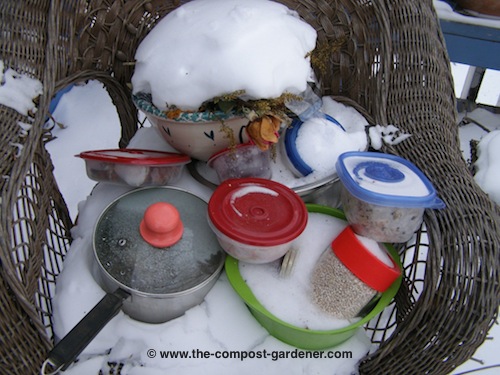
When it warms up I get to try
to pry the semi frozen stuff out into the bin I use as my kitchen
compost bin. I need to do this as I will have pretty much all my mixing
bowls out on the deck by the time things start to thaw. Not fun.
This system is nasty. My deck spends the winter looking like heck and I feel badly, a failure on some level.
What's Happening in Winter
Let’s take a closer look at what’s happening in winter that makes the whole composting process harder.
It's cold...
- The microbes in the frozen winter compost are dormant. The bacteria and fungi survive as spores, the protozoa in cysts and the nematodes as eggs. These forms will make through the winter but for the cold period they are inactive.
- Anything you put in the compost will freeze and thaw. This will shred the material nicely without effort from you making it decompose faster come Spring.
- The snow is too deep, it’s too cold, it’s too slippery… and you just don’t want to make the trek to the compost bin.
It’s just the kitchen scraps...
- The garden compost contributions are over and all you have to add to the compost is a small but steady stream of peels, overdue leftovers, and plate scrapings.
- This stuff is what we call greens, with a low carbon/nitrogen ratio. Most kitchen scraps run 15 to 20 in the C/N ratio.
- Greens left on the counter any length of time will start to stink.
- It would be a good thing to balance this material with browns - the higher carbon material like shredded leaves or paper.
A Winter Composting System that Works
I want to thank one of my readers for this much better idea for coping with the realities of winter.
"All winter long, I collect my garden wastes in plastic pails on the deck
outside my kitchen door where they freeze and thaw in our south Alberta
chinook climate. We generate a lot as I make vegetable juice every
morning. Over the winter I fill about 12 pails full. " An Alberta Canada reader
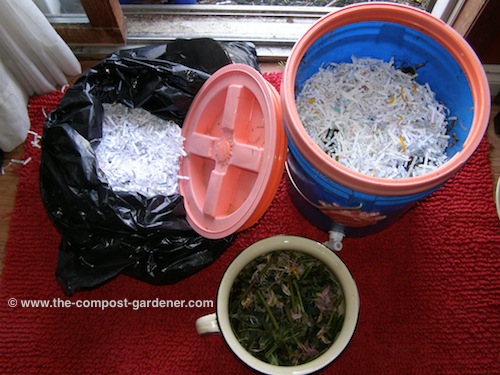
Here’s my new and very much improved winter composting system. It consists of
- A lovely art deco chamber pot that lives on my counter and I use to collect my kitchen scraps.
- Some 5 or 6 gallon buckets. Don’t go any bigger or you won’t be able to move them come Spring when you put them in your compost bin.
- Gamma Seal Lids. These are not absolutely necessary but they do transform an ordinary bucket into a leak proof and pest proof container. Plus they are easy to screw on and off for humans. Remember you’ll be adding to the bucket every day or two.
- A bag of shredded paper. These are my browns for the moment. I didn’t
get my leaves shredded this year as they didn’t bother to fall off the
trees until after the snow fell.
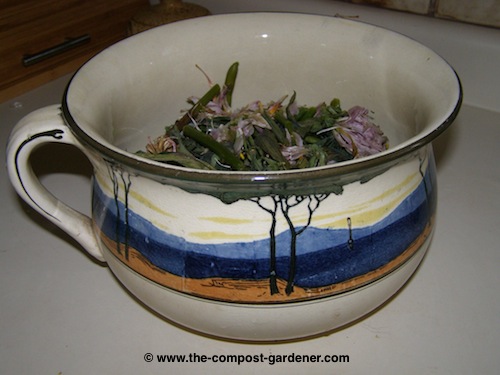
The process is very simple.
- I collect all the food scraps long with used kleenex and paper napkins in my chamber pot.
- Every day or two I open the deck door, bring my bucket in, take off the top, dump in the scraps.
- I cover with a handful or two of shredded paper, put the top back on and then set the bucket back out on the deck.
The daily chore takes less than a minute and I can do it my jammies if I want. In short I’ll do it.
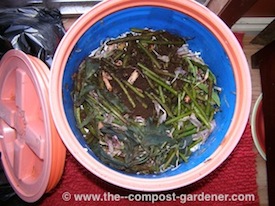 |
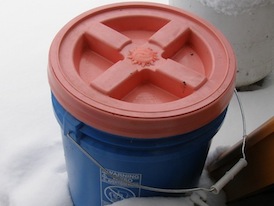 |
Where to Get Buckets and Gamma Seal Lids
Buckets - These you may be able to pick up for free from a deli or even from the dump. The 3.5, 5 and 6 gallon pails all have the same size opening so will fit the gamma seal lids. You can buy them at Hardware Stores.
Gamma Seal Lids - I love these lids. They seem pricey but they are very durable and they make your life easier. You can order gamma seal lids from Amazon. Ordering more than one eases the shipping shock.

What to do Come Spring
In my book Spring is here when the compost in my bin suddenly shrinks. It’s a sure signal the microbes have awakened and are starting their work.
My Alberta friends have 12 buckets full of greens to start their compost. By layering shredded leaves - those compost browns - with their winter composting collection they can fill one of those plastic compost bins such as the Earth Machine in short order.
Essentially that’s all you need to do come Spring. Empty your buckets and make sure you are adding enough high carbon material. Check out our Kitchen Compost page for more details.
You’ll have a nice batch of compost in a few months thanks to your winter efforts and you won’t have frozen to death to get there.